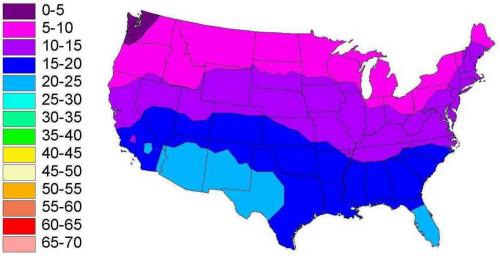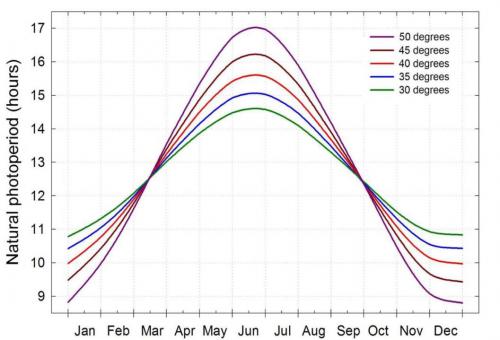Low daily light integrals in northern latitudes
Cloudy weather, less direct sunlight and short day lengths contribute to low daily light integrals during winter.
Greenhouses located in northern latitudes typically have low ambient light conditions during the winter months. In December, the average daily light integral (DLI) outside is only between 5 and 10 mol/m2d in the 13 most northern states (Figure 1). It is less than 5 mol/m2d in western Washington. Light transmission in greenhouses is often between 40 and 65 percent, depending on glazing type and its age and shading from superstructure and equipment. Daily light integrals (DLIs) of 2 to 4 mol/m2d in the greenhouse are not uncommon on cloudy days during this period. Why are light levels so low in the northern United States and how do they compare with other parts of the country?

Figure 1. Range of average daily light integrals (DLI) outdoors for regions of the continental United States in December. The DLI inside greenhouses would typically be about half of these outdoor values. Citation: Korczynski, Logan, and Faust. 2002. Mapping Monthly Distribution of Daily Light Integrals across the Contiguous United States. HortTechnology 12:12-16.
Less direct sunlight, frequent cloudy weather and short day lengths contribute to low DLIs. During the winter in the northern hemisphere, sunlight is less direct because the earth’s axis is pointing away from the sun. Therefore, the same amount of energy and light is distributed over more area. The directness of the sunlight varies between regions of the United States. For example, sunlight is more direct in southern Florida, resulting in an average DLI between 20 and 25 mol/m2d in December; in Illinois, the DLI is only between 10 and 15 mol/m2d (Figure 1). Weather is another factor limiting light availability in certain parts of the country. The Pacific Northwest and the regions around the Great Lakes often experience cloudy weather and frequent precipitation.
Short day length, or photoperiod, also contributes to a low DLI. Figure 2 shows the variation in photoperiod throughout the year at different latitudes. You will notice that locations at 30 degrees north (ex. New Orleans, Louisiana) have less variation in photoperiod through the year than those at 45 degrees north (ex. Portland, Oregon). Therefore, the days are much shorter in the winter in the northern United States compared to locations closer to the equator.

Figure 2. Biological photoperiod fluctuates throughout the year at locations with different latitudes. Locations at 30 degrees north (ex. New Orleans, Louisiana) have less variation in photoperiod during the year than those at 45 degrees north (ex. Portland, Oregon). Photo credit: Erik Runkle
For greenhouses in northern latitudes, the short day lengths and low DLIs in winter directly correspond to periods of peak propagation. Therefore, supplemental (high-intensity) lighting is beneficial when growing young plants during these periods.
To learn more about how low light levels affect plant growth and development, see “How low can you go? Low daily light integrals impact young plant quality and production time” or “The Benefits of Lighted Plugs” from Michigan State University Extension. Additional information on greenhouse lighting can be found on the MSU Floriculture web site.
Dr. Runkle’s work is funded in part by MSU’s AgBioResearch.



 Print
Print Email
Email


